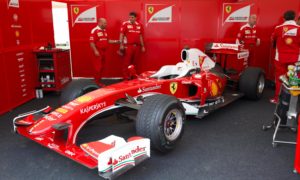This week saw the first outing of most of the 2009 F1 grid, at a sometimes drenched, mostly sodden Portuguese circuit. The teams had mixed results, and it was telling that the 2008 Toro Rosso of Sebastian Buemi was significantly faster than the 2009 cars of all descriptions. However, the appearance of the cars leads some observers to worry not about the beauty or otherwise, but about the potential implications for safety in the sport.
The 2009 cars have two major features which may have compromised the safety of the drivers. The first is the front wing, which is considerably larger than its 2008 predecessors. This will inevitably result in more collisions during on-track battles as the BMW Sauber drivers in particular have acknowledged, which could lead to front wings flying up in the air. More plausibly, it will result in more pitstops, which are where the most injuries in modern F1 have been caused. Imagine half the grid pouring into the pitlane after the first lap in Melbourne and you can appreciate that it is another risk.
The second feature which may affect the safety is the cockpit sides. The sides were first raised for the 1996 season as part of the raft of new measures implemented after the tragic death of Ayrton Senna in 1994. They gradually lowered as time went on to the bare minimum required by the rules, as drivers complained about the lack of visibility the raised sides caused. After Alex Wurz and David Coulthard s coming together in Melbourne in 2007, however, they were raised again for the 2008 season, and have not been lowered for 2009. But perhaps in order to aid visibility with a wider nose and larger front ends, the front of the 2009 cockpit seems to be more exposed than before. In one picture of his test in the new car, keen observers can see the bottom of Lewis Hamilton s helmet from a side view.
These two issues, when put together, could have serious ramifications for the well-being of the drivers. Let no-one forget that one of the causes of Senna s death was the entry of his right front wheel into the cockpit. The spectre of this happening again, while unlikely, is possible. The bigger front wings increase the likelihood of some bodywork breaking off, and if it s true that the aperture between the front of the cockpit and the raised side is now larger, and the cockpit is more open, that adds to the danger.
Moreover, Renault s failed crash test in the last few weeks raises the old question of whether everyone involved in this sport today really appreciates its risks. It s tempting, when there hasn t been a major injury or fatality for a while, to tacitly assume we are in a post-tragedy era, to assume athat sort of thing doesn t happen any more -type attitude. The sport was extremely fortunate that Robert Kubica didn t have a second front impact after his first in Canada in 2007, and equally extremely fortunate that Coulthard’s Red Bull passed five inches in front of Alex Wurz rather than hitting his head. These are matters for which no-one can legislate, and it could still happen.
Outside all British motor sport venues there is a disclaimer which says motorsport is dangerous . Simply because it is the pinnacle of the sport, Formula One does not and can never escape this universal truth. What the FIA and the teams can do, however, is to ensure the risk to the drivers is minimal. In 2009, in search of close racing, they may not have done that.








